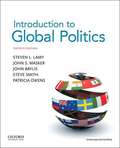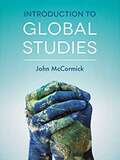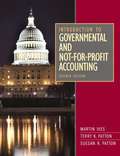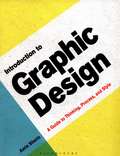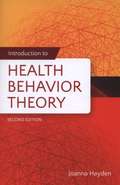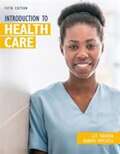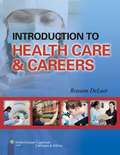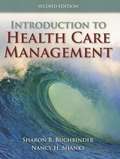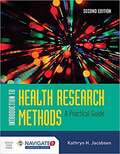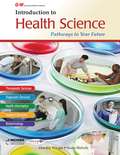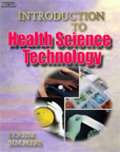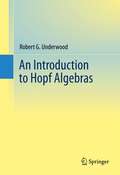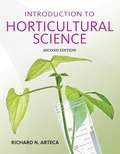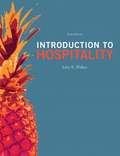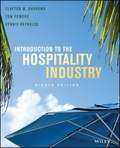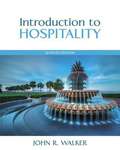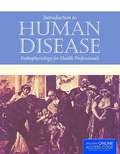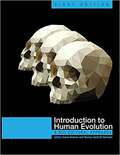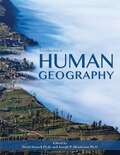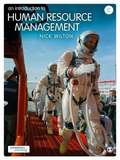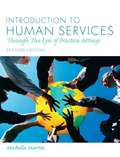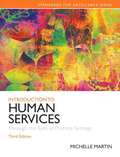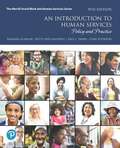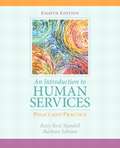- Table View
- List View
Introduction To Global Politics (Fourth Edition)
by Steve Lamy John MaskerIntroduction to Global Politics, Fourth Edition, provides students with a current, engaging, and non-U.S. perspective on global politics. It shows students how to analyze global political events using theoretical approaches-both mainstream and alternative-and emphasizes non-state actors more than any other global politics text.
Introduction to Global Studies
by John McCormickThis textbook provides a multidisciplinary introduction to Global and International Studies. Offering unrivalled breadth and depth, it covers all the key dimensions of the topic, including broad introductions to international politics and economics, and focused surveys of topics from human rights and migration to conflict and the environment. <p><p>John McCormick’s lucid writing style renders complex information understandable to all students. Full-colour photographs, maps, tables and figures bring the subject to life and innovative pedagogical features emphasize the importance of understanding perspectives and experiences different from one’s own worldview. <p><p>Assuming no prior knowledge of the subject, this textbook is ideal for undergraduate students worldwide who are taking introductory modules in Global and International Studies. The text can also be used by undergraduate students taking courses on Globalization.
Introduction to Governmental and Not-for-profit Accounting (7th Edition)
by Martin Ives Larry A. Johnson Joseph R. Razek Gordon A. Hosch Terry K. Patton Suesan R. PattonCovering the essentials of fund accounting, this flexible book introduces the reader to the basic accounting principles at work in both governmental and not-for-profit organizations.
Introduction to Graphic Design: A Guide to Thinking, Process and Style (Required Reading Range #74)
by Aaris SherinFor a great foundation as a graphic design student, look no further than Aaris Sherin's Introduction to Graphic Design. Sherin will introduce you to the formal structure of graphic design, so you can understand and utilise the main techniques of your chosen profession, and learn how they apply to print and screen-based projects. Whether you need to conceptualise a new poster, develop an exciting advertisement, structure an app or create eye-catching signage, chapters can be read in any order you choose, depending on which area you wish to concentrate. <p><p> Whatever your approach, you'll be encouraged to use critical thinking, visual exploration and understand the special relationship graphic designers have to creative problem solving. There are also chapters devoted to imagery, color, and typography, using a thematic approach to creative problem-solving. With over 500 images showing examples from international designers, helpful diagrams, highlighted key terms and concepts, Design in Action case studies, exercises and chapter-by-chapter Dos and Don'ts, Introduction to Graphic Design will give newcomers to graphic design the confidence to give visual form to concepts and ideas.
Introduction to Health Behavior Theory (Second Edition)
by Joanna Aboyoun HaydenIntroduction to Health Behavior Theory, Second Edition is designed to provide students with an easy to understand, interesting, and engaging introduction to the theoretical basis of health education. Written with the undergraduate in mind, the text uses comprehensive and accessible explanations to help students understand what theory is, how theories are developed, and what factors influence health behavior theory. Covering the more frequently used health behavior theories, the author breaks each theory into concepts and constructs to enhance comprehension and encourage students to discover how these theories can be put into practice. New to the Second Edition:* Data, information, and illustrations updated throughout, including the new "My Plate"* A new Theory in Action article and new classroom activities in each theory chapter* New and revised chapters on Social Ecological Models and Social Capital Theory
Introduction to Health Care and Careers
by Roxann Delaet<p><i>Introduction to Health Care and Careers</i> provides students beginning their health care education with the fundamentals they need to develop their personal and professional skills, understand their chosen profession, and succeed in the world of health care. It meets the growing market demand for a book that gives the best of both worlds—skill development and career choice information. The text begins with today’s health care system, health care economics, and law and ethics, providing important context for the personal, professional, and workplace skills that follow. From there, students move on to an overview of careers in health care and detailed profiles of the most in-demand professions. The book closes with brief chapters on anatomy and physiology to prepare students for the rest of their health care education. <p>With its student friendly approach,<i>Introduction to Health Care and Careers</i> is the essential resource for introductory health care courses, striking the perfect balance between skill development and up-to-date career choice information–everything health care students need to succeed.</p>
Introduction To Health Care Management
by Sharon B. Buchbinder Nancy H. ShanksIntroduction to Health Care Management is a concise, reader-friendly, introductory healthcare management book that covers a wide variety of healthcare settings, from hospitals to nursing homes and clinics. Filled with examples to engage the reader's imagination, the important issues in healthcare management, such as ethics, cost management, strategic planning and marketing, information technology, and human resources, are all thoroughly covered. Guidelines and rubrics along with numerous case studies make this text both student-friendly and teacher friendly. It is the perfect resource for students of healthcare management, nursing, allied health, business administration, pharmacy, occupational therapy, public administration, and public health. "Drs. Buchbinder and Shanks have done a masterful job in selecting topics and authors and putting them together in a meaningful and coherent manner. Each chapter of the book is designed to give the student the core content that must become part of the repertoire of each and every healthcare manager, whether entry level or senior executive. Each of the chapters and accompanying cases serve to bring to life what it means to be a truly competent healthcare manager.
Introduction To Health Research Methods
by Kathryn H. JacobsenThis clear, practical, and straightforward text demystifies the research process and empowers students and other new investigators to conduct their own original research projects. In five sections, Introduction to Health Research Methods describes the entire research process beginning with the identification of a research question and the selection of a study approach, proceeding through the collection and analysis of data and the preparation of a formal scientific report, and ending with academic and professional presentations and publishing. By breaking down the process into manageable steps, Introduction to Health Research Methods communicates the excitement and importance of health researchâ€"and encourages readers to make their own contribution to improving the health of individuals and communities through research. <P><P> The Second Edition is a thorough update that offers: - A new chapter on mentorship and other professional development opportunities - A new chapter on grant writing with sections on funding sources, finding grant opportunities, proposal writing, budgeting, and grant management - A new chapter introducing several analysis tools that move beyond standard biostatistical techniques such as GIS, mathematical modeling, and economic analysis - A comprehensive walk through of successful writing strategies with dozens of ideas for how to get started on writing and stay motivated - New information on qualitative studies including interviewing, focus group discussions, coding and analysis, mixed methods research, and monitoring and evaluation
Introduction to Health Science: Pathways to Your Future
by Dorothy J. Winger Susan BlahnikIntroduction to Health Science: Pathways to Your Future is a pathway-focused textbook program that helps you explore and prepare for healthcare careers. Organized into untis based on the five health science pathways, the text covers all the skills and knowledge areas included in the National Health Science Standards. Assessment activities at the end of each chapter offer multiple opportunities for students to simulate heathcare careers, practice skills, and to think deeply about the information they've learned.
Introduction To Health Science Technology
by Louise SimmersIntroduction to Health Science Technology covers the core information needed to pursue a career in health care from an introduction of the health care industry and the basics of a health care system to overview of health care careers and legal and ethical responsibilities of health care workers to medical terminology and basic anatomy and physiology.
An Introduction to Hopf Algebras
by Robert G. UnderwoodWith wide-ranging connections to fields from theoretical physics to computer science, Hopf algebras offer students a glimpse at the applications of abstract mathematics. This book is unique in making this engaging subject accessible to advanced undergraduate and beginning graduate students. After providing a self-contained introduction to group and ring theory, the book thoroughly treats the concept of the spectrum of a ring and the Zariski topology. In this way the student transitions smoothly from basic abstract algebra to Hopf algebras. The importance of Hopf orders is underscored with applications to algebraic number theory, Galois module theory and the theory of formal groups. By the end of the book, readers will be familiar with established results in the field and ready to pose research questions of their own.
Introduction to Horticultural Science (Second Edition)
by Richard N. ArtecaDesigned to provide readers with a full appreciation of the wonderful world of horticultural science, the Second Edition of INTRODUCTION TO HORTICULTURAL SCIENCE covers everything the reader needs to know in a comprehensive format that is easy to understand. Coverage includes critical topics such as fundamental concepts, cutting edge research, careers in horticulture, the relationship between horticulture and the environment, classification of plants, and plant anatomy. Readers are also introduced to key concepts such as plant propagation, media, nutrients and fertilizers, plants and the environment, plant growth regulators, post harvest physiology and pest management, greenhouse structures, nursery site selection, development and facilities, producing nursery crops, and floral design. Through enhanced visual aids and the inclusion of recent trends in the field, the second edition has been designed to peak reader interest and improve reader understanding.
Introduction to Horticulture (4th edition)
by Charles B. Schroeder Eddie Dean Seagle Lorie M. Felton John M. Ruter William Terry Kelly Gerard KrewerThe Fourth Edition of Introduction to Horticulture represents a major step forward for horticulture books in agricultural education. The attractive, student-friendly book has been expanded and made much more appealing. Changes from the prior editions have made this book increasingly useful in the hands of students.
Introduction to Hospitality (6th edition)
by John R. WalkerThe Sixth Edition of Introduction to Hospitality focuses on hospitality operations while offering a broad, comprehensive foundation of current knowledge about the world's largest industry. The text is organized into five sections: the hospitality industry and tourism; lodging; restaurants, managed services, and beverages; recreation, theme parks, clubs, and gaming entertainment; and assemblies and event management.
Introduction To The Hospitality Industry
by Clayton W. Barrows Tom Powers Dennis ReynoldsIf any phrase characterizes the hospitality and tourism industry today it would probably be constantly changing.
Introduction to Hospitality (Seventh Edition)
by John R. WalkerPrepares students to succeed in any area of the hospitality industry. Introduction to Hospitality, 7/e, focuses on hospitality operations while offering a broad, comprehensive view of the world’s largest industry. The text is organized into four sections: hospitality and lodging; beverages, restaurants, and managed services; tourism, recreation, attractions, clubs, and gaming; and assemblies, events, attractions, leadership, and management. Each section includes real-world profiles, first-hand accounts, and engaging case studies to help readers connect with the material and foster an appreciation of the industry’s unique enthusiasm and passion. New photos, page layouts, and hands-on examples help students understand the how-to aspects of today’s hospitality industry. Updated to reflect today’s trends and realities, the Seventh Edition contains new coverage of spas, updated and new corporate profiles, salary information, hospitality-related technologies, and more!
Introduction To Human Disease: Pathophysiology For Health Professionals, 6th Edition
by Agnes G. Loeffler Michael N. HartIntroduction to Human Disease: Pathophysiology for Health Professionals, Sixth Edition provides a broad overview of the most common and important human diseases for students pursuing careers in the health professions. Comprehensive yet accessible, it addresses the aspects of disease epidemiology, diagnosis, and treatment that are essential to clinical practice. The Sixth Edition of this popular text has been thoroughly updated to cover the latest advances in medical knowledge and practice, especially with regard to mental health and nutritional disorders. It also includes additional clinical information on treatments for diseases. Designed to facilitate learning, this essential reference features new full-color photos and illustrations, learning objectives, and practice questions for review and assessment. Introduction to Human Disease: Pathophysiology for Health Professions, Sixth Edition will help students gain a solid foundation in disease pathology and medical terminology to help them throughout their medical education. KEY FEATURES* Provides a comprehensive introduction to the essential aspects of human disease* Covers the most common and important human diseases, including mental illnesses* Facilitates learning with chapter objectives, key terms, and practice questions * Includes more than 400 full-color illustrations, photos, and tablesNEW TO THE SIXTH EDITION* New photos and illustrations* New and updated resources for instructors and students* Updated content reflects the current state of medical knowledge and practice* More clinical information, including general and specific treatments for diseases with an emphasize on common laboratory tests* Chapter 26: Infectious Diseases and Chapter 27: Immunologic Diseases are revised and now included in Section 4: Multiple Organ System Diseases* Chapters 24: Mental Illness and 30: Nutritional Disorders are revised, to bring them up-to-date with current health problems (e. g. obesity), concepts, and terminologies
Introduction To Human Evolution: A Bio-Cultural Approach
by Gillian Crane-Kramer Roman Gastrell Harrison"Introduction to Human Evolution has been developed in direct response to student feedback on the standard textbook approach to the subject matter. Concise and filled with engaging images, the book makes evolution, primatology, and human variation appealing to today's learners. <p><p> The book introduces readers to issues surrounding the theory of evolution, sheds light on questions about what evolution is or isn't, and discusses how we know what we think we do about it. <p><p> Readers will learn about early hominins, the Australopithecines, and the genus Homo. The book also addresses population history and genetics, adaptation and acclimatization, and anatomically modern humans. It concludes with the big question—where will we go from here? <p><p> Each chapter is a balance of text, exercises, graphs, and visuals. The exercise worksheets support independent learning, and answers are provided to allow for self-assessment. <p><p> Introduction to Human Evolution is an excellent choice for courses in anthropology and biology. It is accessible to non-majors, but can also be used in introductory courses for science majors. <p><p> Gillian Crane-Kramer earned her Ph.D. in archeology/biological anthropology from the University of Calgary, Canada. She is a professor in the Department of Anthropology at the State University of New York at Plattsburgh. Dr. Crane-Kramer is an Osteologist who specializes in the evolution of infectious disease through time. <p><p> Roman Harrison earned his Ph.D. in archaeology at the University of Calgary. Dr. Harrison is a lecturer in the Department of Sociology and Anthropology at Mount Royal University in Calgary, Alberta, and a member of the Canadian Association for Physical Anthropology.
Introduction to Human Geography
by David Dorrell Joseph P. HendersonGeography is a diverse discipline that has some sort of connection to most every other academic discipline. This connection is the spatial perspective, which essentially means if a phenomenon can be mapped, it has some kind of relationship to geography. Studying the entire world is a fascinating subject, and geographical knowledge is fundamental to a competent understanding of our world. You will learn what geography is as well as some of the fundamental concepts that underpin the discipline. These fundamental terms and concepts will be interwoven throughout the text, so a sound understanding of these topics is critical as you delve deeper into the chapters that follow. By the end of the first chapter itself, you will begin to think like a geographer.
An Introduction to Human Resource Management
by Dr Nick WiltonThe second edition of Nick Wilton's An Introduction to Human Resource Management continues to provide an engaging and holistic overview of the role of Human Resource Management in its contemporary context. It reflects on current trends, the labour market and the global economy while offering a critical yet accessible treatment of both theoretical and practical issues relating to Human Resource Management. <P><P> * New Full Colour Layout makes the text easy to read and navigate <P> * HR in Practice boxes illustrate how theory can be applied in practice <P> * Ethical Insights present ethical considerations for budding practitioners<P> * Global Insights highlight practices around the world <P> * Research Insights invite you to explore academic research <P> * Case Studies relate theory to real organisations such as Tesco, Intel and Lloyds TSB <P> * Self-test questions are ideal for revision <P> * Further Online Reading provides free access to scholarly journal articles <P> * Glossary and Definitions explain key terms <P> * Podcasts summarise key topics and highlight employability skills <P> Visit: www.sagepub.co.uk/wilton2 to access additional learning resources including extended case studies, chapter summaries, podcasts and journal articles.<P> This book is essential reading for undergraduate, postgraduate and MBA students, including those studying for their CIPD qualifications.
Introduction to Human Services: Through the Eyes of Practice Settings (2nd edition)
by Michelle MartinThis highly readable human services text offers a generalist view of the breadth and scope of human services. This text uses various practice settings as a lens for examining the role and functions of the human service professional. Because the human services profession grew out of a concern about social problems that prevented people from getting their needs met, it is important to examine the generalist role of human service professionals. In addition, exploring the nature of working with individuals, families, or groups is more meaningful when explored within the context of a particular practice setting.
Introduction To Human Services: Through The Eyes Of Practice Settings
by Michelle E. MartinProvides readers with an understanding of the Human Services Profession. Introduction to Human Services: Through the Eyes of Practice Settings, 3/e explores human services through the lens of the most common practice settings where human service professionals work. This title also provides information about social problems within a socio-political context allowing readers to think about ways in which culture and ideology influence people's perspectives. Standards for Excellence series -- Each chapter highlights the national standards set by the Council for Standards in Human Service Education (CSHSE). Critical thinking questions throughout reinforces this integration. Learning Goals Upon completing this book, readers will be able to: Understand the issues pertinent to human services from new perspectives. Challenge the status quo of human services. Recognize their own stereotypical thinking that may create barriers to becoming effective helpers.
An Introduction to Human Services: Policy and Practice
by Barbara Schram Betty Mandell Paul Dann Lynn PetersonComplete, up-to-date coverage of social welfare programs and policies with special coverage of how history, politics, and the economy shape these programs This text puts the field of human services into a historical context, provides insights into the social welfare field, and gives concrete examples of how primary intervention strategies are put into daily practice in human service agencies. It presents the many options offered in the field of human services and discusses the stresses that a human service worker will face in day-to-day work, with practical suggestions for avoiding burnout. The text compares the U.S. social welfare systems to systems in other countries, and uses a strong multicultural and social systems approach that distinguishes it from other texts. Teaching & Learning Experience Personalize Learning — MyHelpingLab delivers proven results in helping students succeed, provides engaging experiences that personalize learning, and comes from a trusted partner with educational expertise and a deep commitment to helping students and instructors achieve their goals. Engage Students — Outstanding pedagogy, including examples, cases, anecdotes, and interviews, keeps students interested. Explore Current Issues — Contemporary issues are incorporated throughout the text to provide students with the most up-to-date coverage; topics include: cyberbullying, immigration, and health care reform. Support Instructors — An Instructor's Manual and Test Bank, Computerized Test Bank (MyTest), MyHelpingLab with Pearson eText, and PowerPoint presentations, and BlackBoard and WebCT Test Item File provide instructors with additional support. Note: MyHelpingLab does not come automatically packaged with this text. To purchase MyHelpingLab, please visit: www.myhelpinglab.com or you can purchase a valuepack of the text + MyHelpingLab (at no additional cost). VP: 0205060560
An Introduction To Human Services: Policy And Practice
by Barbara Schram Betty Reid MandellComplete, up-to-date coverage of social welfare programs and policies with special coverage of how history, politics, and the economy shape these programs This text puts the field of human services into a historical context, provides insights into the social welfare field, and gives concrete examples of how primary intervention strategies are put into daily practice in human service agencies. <P> It presents the many options offered in the field of human services and discusses the stresses that a human service worker will face in day-to-day work, with practical suggestions for avoiding burnout. The text compares the U. S. social welfare systems to systems in other countries, and uses a strong multicultural and social systems approach that distinguishes it from other texts.
